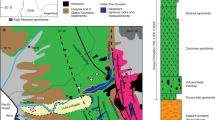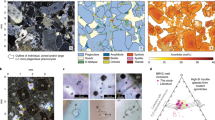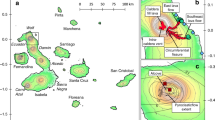Abstract
The potential for cataclysmic volcanic eruptions1 depends on the volume of magma stored in shallow crustal reservoirs and the amount of time over which magma can accumulate without cooling and crystallizing to form a pluton of solid rock. Magma reservoir volume and longevity are, in turn, controlled by the flux of new magma into the system and the crystal content of the reservoir2,3,4,5,6. To understand why some magmas erupt, whereas others solidify in the crust, the timescales for crystal growth and upper-crust magma residence must be determined from both erupted volcanic rocks and intruded plutonic rocks7. However, our understanding of these timescales is largely restricted to volcanic rocks only8,9,10,11,12,13,14 and measurements from plutonic rocks are missing. Here we use U–Pb geochronological dating of zircon crystals sampled from a seven-million-year-old upper crustal pluton in Elba, Italy. The zircon crystals were found as inclusions within the cores and rims of 6–8-cm-long potassium-feldspar megacrysts and constrain the rate of megacryst growth to 0.2–1.1 μm yr−1. We combine the measured growth rates with petrological observations and phase-equilibrium modelling to show that the transition from eruptible magmas to immobile granitic mush and pluton formation occurred in just 10–40 thousand years. This short time window for a potential eruption implies that some magmas reside in upper crustal reservoirs for only a brief period before eruption.
This is a preview of subscription content, access via your institution
Access options
Subscribe to this journal
Receive 12 print issues and online access
$259.00 per year
only $21.58 per issue
Buy this article
- Purchase on Springer Link
- Instant access to full article PDF
Prices may be subject to local taxes which are calculated during checkout



Similar content being viewed by others
References
Bachmann, O. & Bergantz, G. The magma reservoirs that feed supereruptions. Elements 4, 17–21 (2008).
Caricchi, L. et al. Non-Newtonian rheology of crystal-bearing magmas and implications for magma ascent dynamics. Earth Planet. Sci. Lett. 264, 402–419 (2007).
Schöpa, A. & Annen, C. The effects of magma flux variations on the formation and lifetime of large silicic magma chambers. J. Geophys. Res. 118, 926–942 (2013).
Bachmann, O. On the origin of crystal-poor rhyolites: Extracted from batholithic crystal mushes. J. Petrol. 45, 1565–1582 (2004).
Huber, C., Bachmann, O. & Dufek, J. Thermo-mechanical reactivation of locked crystal mushes: Melting-induced internal fracturing and assimilation processes in magmas. Earth Planet. Sci. Lett. 304, 443–454 (2011).
Gelman, S. E., Gutierrez, F. J. & Bachmann, O. On the longevity of large upper crustal silicic magma reservoirs. Geology 41, 759–762 (2013).
Costa, F. & Dungan, M. Short time scales of magmatic assimilation from diffusion modeling of multiple elements in olivine. Geology 33, 837–840 (2005).
Costa, F., Chakraborty, S. & Dohmen, R. Diffusion coupling between trace and major elements and a model for calculation of magma residence times using plagioclase. Geochim. Cosmochim. Acta 67, 2189–2200 (2003).
Druitt, T. H., Costa, F., Deloule, É., Dungan, M. & Scaillet, B. Decadal to monthly timescales of magma transfer and reservoir growth at a caldera volcano. Nature 482, 77–80 (2012).
Condomines, M. Timescales of magma chamber processes and dating of young volcanic rocks. Am. Mineral. 52, 125–174 (2003).
Claiborne, L. L., Miller, C. F., Flanagan, D. M., Clynne, M. A. & Wooden, J. L. Zircon reveals protracted magma storage and recycling beneath Mount St. Helens. Geology 38, 1011–1014 (2010).
Cooper, K. M. & Kent, A. J. R. Rapid remobilization of magmatic crystals kept in cold storage. Nature 506, 480–483 (2014).
Ruprecht, P. & Cooper, K. M. Integrating the uranium-series and elemental diffusion geochronometers in mixed magmas from Volcan Quizapu, Central Chile. J. Petrol. 53, 841–871 (2012).
Schmitt, A. K. et al. Acigöl rhyolite field, Central Anatolia (part 1): High-resolution dating of eruption episodes and zircon growth rates. Contrib. Mineral. Petrol. 162, 1215–1231 (2011).
Mills, R. D. & Coleman, D. S. Temporal and chemical connections between plutons and ignimbrites from the Mount Princeton magmatic center. Contrib. Mineral. Petrol. 165, 961–980 (2013).
Annen, C. From plutons to magma chambers: Thermal constraints on the accumulation of eruptible silicic magma in the upper crust. Earth Planet. Sci. Lett. 284, 409–416 (2009).
Rosenbaum, G. & Lister, G. S. Neogene and Quaternary rollback evolution of the Tyrrhenian Sea, the Apennines, and the Sicilian Maghrebides. Tectonics 23, TC1013 (2004).
Gasparon, M., Rosenbaum, G., Wijbrans, J. & Manetti, P. The transition from subduction arc to slab tearing: Evidence from Capraia Island, northern Tyrrhenian Sea. J. Geodyn. 47, 30–38 (2009).
Rocchi, S., Westerman, D. S., Dini, A. & Farina, F. Intrusive sheets and sheeted intrusions at Elba Island, Italy. Geosphere 6, 225–236 (2010).
Farina, F., Dini, A., Innocenti, F., Rocchi, S. & Westerman, D. S. Rapid incremental assembly of the Monte Capanne pluton (Elba Island, Tuscany) by downward stacking of magma sheets. Geol. Soc. Am. Bull. 122, 1463–1479 (2010).
Bussy, F. Pétrogenèse des enclaves microgrenues associées aux granitoïdes calco-alcalins: Exemple des massifs varisque du Mont-Blanc (Alpes occidentales) et Miocène du Monte Capanne (Ile d’Elbe, Italie). Mémoire de Géologic, Lausanne 7, 1–309 (1991).
Westerman, D. S., Dini, A., Innocenti, F. & Rocchi, S. Rise and fall of a nested Christmas-tree laccolith complex, Elba Island, Italy. Geol. Soc. Lond. Spec. Publ. 234, 195–213 (2004).
Dini, A., Innocenti, F., Rocchi, S., Tonarini, S. & Westerman, D. S. The magmatic evolution of the late Miocene laccolith–pluton–dyke granitic complex of Elba Island, Italy. Geol. Magn. 139, 1–23 (2002).
Gagnevin, D. Microchemical and Sr isotopic investigation of zoned K-feldspar megacrysts: Insights into the petrogenesis of a granitic system and disequilibrium crystal growth. J. Petrol. 46, 1689–1724 (2005).
Johnson, B. R. & Glazner, A. F. Formation of K-feldspar megacrysts in granodioritic plutons by thermal cycling and late-stage textural coarsening. Contrib. Mineral. Petrol. 159, 599–619 (2010).
Glazner, A. F. & Johnson, B. R. Late crystallization of K-feldspar and the paradox of megacrystic granites. Contrib. Mineral. Petrol. 166, 777–799 (2013).
Gualda, G. A. R., Ghiorso, M. S., Lemons, R. V. & Carley, T. L. Rhyolite-MELTS: A modified calibration of MELTS optimized for silica-rich, fluid-bearing magmatic systems. J. Petrol. 53, 875–890 (2012).
Wolfe, E. W. & Hoblitt, R. P. in Fire and Mud: Eruptions and Lahars of Mount Pinatubo, Philippines (eds Newhall, C. G. & Punongbayan, R. S.) 751–766 (Philippine Inst. Volcanol. & Seismol./Univ. Washington Press, 1996).
Tilling, R. I. Eruptions of the Mount St. Helens: Past, Present, and Future (US Geol. Survey, 1984).
Acknowledgements
Funding for this project was provided by the Swiss National Science Foundation and Princeton University. We thank F. Bussy for assistance in the field and use of thin sections. We thank C. Annen and S. Bowring for comments that improved an early version of this manuscript.
Author information
Authors and Affiliations
Contributions
M.B. and B.S. jointly conceived the project, obtained funding, developed the interpretations and wrote the manuscript. Geochronology and Rhyolite-MELTS modelling was carried out by M.B. under the supervision of B.S.
Corresponding author
Ethics declarations
Competing interests
The authors declare no competing financial interests.
Supplementary information
Supplementary Information
Supplementary Information (PDF 5450 kb)
Rights and permissions
About this article
Cite this article
Barboni, M., Schoene, B. Short eruption window revealed by absolute crystal growth rates in a granitic magma. Nature Geosci 7, 524–528 (2014). https://doi.org/10.1038/ngeo2185
Received:
Accepted:
Published:
Issue Date:
DOI: https://doi.org/10.1038/ngeo2185
This article is cited by
-
The magmatic evolution of South-East Crater (Mt. Etna) during the February–April 2021 sequence of lava fountains from a mineral chemistry perspective
Bulletin of Volcanology (2023)
-
Syntectonic magmatism and reactivation of collisional structures during late-Variscan shearing (SW Sardinia, Italy)
International Journal of Earth Sciences (2022)
-
Diverse late-stage crystallization and storage conditions in melt domains from the Youngest Toba Tuff revealed by age and compositional heterogeneity in the last increment of accessory phase growth
Contributions to Mineralogy and Petrology (2019)
-
On the origin of alkali feldspar megacrysts in granitoids: the case against textural coarsening
Contributions to Mineralogy and Petrology (2019)
-
Multiple timescale constraints for high-flux magma chamber assembly prior to the Late Bronze Age eruption of Santorini (Greece)
Contributions to Mineralogy and Petrology (2018)



